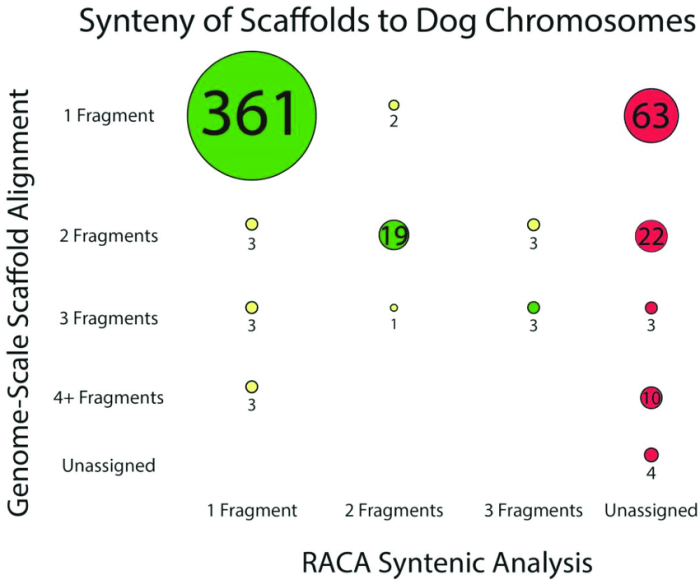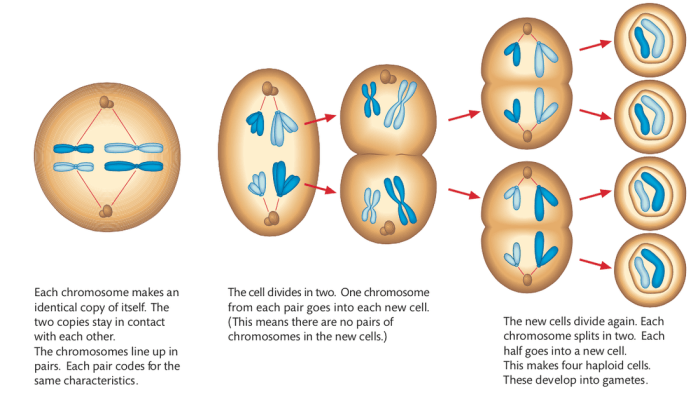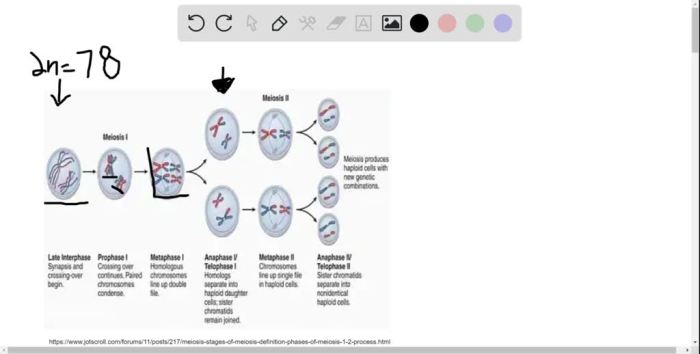If a dog cell has 72 chromosomes, it embarks on a unique genetic journey that sets it apart from other species. This extraordinary chromosome count shapes canine genetics, influences breed characteristics, and presents intriguing implications for veterinary medicine.
Delving into the realm of comparative cytogenetics, we uncover the evolutionary tapestry woven by chromosome count. By comparing dogs to other mammals, we gain insights into the interconnectedness of species and the profound influence of genetic diversity.
Chromosome Count in Dogs

The chromosome count in a dog cell is significant because it determines the genetic makeup of the dog. Dogs have 72 chromosomes, which is more than humans (46) but fewer than some other species, such as horses (64) and cats (38). The number of chromosomes in a cell is species-specific and plays a crucial role in genetic inheritance, as each chromosome carries specific genes.
Comparative Chromosome Counts
The chromosome count of dogs is relatively high compared to other mammals. Humans have 46 chromosomes, while cats have 38, and mice have 40. This difference in chromosome count is thought to be due to evolutionary adaptations and genetic drift.
The higher chromosome count in dogs may have provided them with a genetic advantage in terms of adaptability and survival in diverse environments.
Implications for Dog Genetics and Health
The chromosome count in dogs has implications for their genetics and health. The presence of 72 chromosomes means that dogs have a large gene pool, which contributes to genetic diversity and reduces the risk of inherited diseases. However, certain genetic disorders in dogs can be linked to specific chromosomes, and the presence of multiple copies of a particular chromosome can increase the risk of developing those disorders.
Understanding the chromosome count and genetic makeup of dogs is essential for responsible breeding practices and the prevention of inherited diseases.
Genetic Diversity in Dogs

The number of chromosomes in a cell contributes to the genetic diversity within dog breeds. Each chromosome carries a set of genes, and the combination of genes on different chromosomes determines an individual’s traits. Dogs with a higher number of chromosomes have a greater potential for genetic diversity, as they can inherit a wider range of genes from their parents.
For example, the golden retriever has 78 chromosomes, while the boxer has 74. This difference in chromosome count contributes to the different physical characteristics and health outcomes of these two breeds. Golden retrievers are typically larger and more athletic than boxers, and they are also less prone to certain health conditions, such as hip dysplasia.
Maintaining genetic diversity in dog populations is important for several reasons. First, it helps to prevent the spread of genetic diseases. If a population of dogs has a low level of genetic diversity, it is more likely that individuals will inherit harmful recessive genes from both parents.
These genes can cause a variety of health problems, including blindness, deafness, and hip dysplasia.
Second, genetic diversity helps to ensure that dog breeds remain adaptable to changing environmental conditions. As the environment changes, dogs with certain traits may become more or less desirable. For example, in a warmer climate, dogs with shorter coats may be more popular than dogs with longer coats.
If a dog population has a high level of genetic diversity, it is more likely to produce individuals with the traits that are best suited to the current environment.
Maintaining Genetic Diversity
There are several ways to maintain genetic diversity in dog populations. One important strategy is to avoid inbreeding. Inbreeding occurs when dogs are bred to closely related individuals, such as siblings or parents and offspring. Inbreeding can lead to a decrease in genetic diversity, as it increases the likelihood that individuals will inherit harmful recessive genes from both parents.
Another important strategy for maintaining genetic diversity is to introduce new bloodlines into dog populations. This can be done by importing dogs from other countries or by breeding dogs from different breeds. Introducing new bloodlines helps to increase the genetic diversity of a population and reduces the risk of inbreeding.
Finally, it is important to promote responsible breeding practices. This means breeding dogs for health and temperament, rather than for appearance or other superficial traits. Responsible breeding helps to ensure that dogs are healthy and well-adjusted, and it also helps to maintain genetic diversity in dog populations.
Comparative Cytogenetics

Comparative cytogenetics is the study of the chromosome number and structure of different species. It helps us understand the evolutionary relationships between species and provides insights into their genetic diversity.
Chromosome Number and Structure in Mammals
The following table compares the chromosome number and structure of dogs to other mammals:
| Species | Chromosome Number | Chromosome Structure |
|---|---|---|
| Humans | 46 | 22 pairs of autosomes, 1 pair of sex chromosomes (XX or XY) |
| Cats | 38 | 18 pairs of autosomes, 1 pair of sex chromosomes (XX or XY) |
| Horses | 64 | 32 pairs of autosomes, 1 pair of sex chromosomes (XX or XY) |
| Dogs | 78 | 39 pairs of autosomes, 1 pair of sex chromosomes (XX or XY) |
As can be seen from the table, dogs have a higher chromosome number than humans, cats, and horses. This difference in chromosome number is thought to have arisen through a process of chromosomal fusion, in which two or more chromosomes fuse together to form a single chromosome.
Evolutionary Implications of Chromosome Differences
The differences in chromosome number and structure between species can have evolutionary implications. For example, the higher chromosome number in dogs may have given them an advantage in terms of genetic diversity, as it allows for a greater number of gene combinations.
Comparative cytogenetics is a valuable tool for understanding the evolutionary relationships between species. By studying the chromosome number and structure of different species, we can gain insights into their genetic diversity and how they have evolved over time.
Clinical Significance

The unusual chromosome count of 72 in dogs has significant clinical implications. It affects the diagnosis and treatment of genetic disorders and highlights the importance of chromosome analysis in veterinary medicine.
Impact on Genetic Disorders, If a dog cell has 72 chromosomes
The presence of 72 chromosomes can alter the expression and inheritance patterns of genetic disorders in dogs. Some genetic conditions may be more prevalent or severe in breeds with this unique chromosome count. Accurate diagnosis of these disorders requires specialized genetic testing and analysis, considering the atypical chromosome number.
Chromosome Analysis in Veterinary Medicine
Chromosome analysis, such as karyotyping, plays a crucial role in veterinary medicine. It helps identify chromosomal abnormalities, including numerical and structural variations. This information aids in diagnosing genetic disorders, predicting disease prognosis, and guiding breeding programs to reduce the risk of inherited conditions.
Future Research Directions

Delving deeper into the chromosome count of dogs holds immense potential for advancing our understanding of canine biology and genetics. By exploring various avenues of research, we can uncover novel insights and gain a more comprehensive perspective on this fascinating topic.
One promising area for future research is the investigation of the relationship between chromosome count and breed diversity. By comparing the chromosome counts of different dog breeds, we can identify patterns and correlations that may shed light on the genetic basis of breed-specific traits and characteristics.
This knowledge can contribute to the development of targeted breeding strategies aimed at preserving and enhancing desirable traits within specific breeds.
Comparative Cytogenetics
Comparative cytogenetics offers another valuable avenue for research. By comparing the chromosome counts and structures of dogs to those of other species, we can gain insights into the evolutionary relationships and genetic diversity among canids. Such comparative studies can help us understand the mechanisms underlying chromosomal rearrangements and the role they play in speciation and adaptation.
Clinical Significance
Further research is also warranted to explore the clinical significance of chromosome count variations in dogs. By studying the impact of chromosomal abnormalities on canine health and disease, we can develop improved diagnostic tools and therapeutic interventions. This knowledge can contribute to the advancement of veterinary medicine and enhance the well-being of our canine companions.
FAQ Summary: If A Dog Cell Has 72 Chromosomes
Why do dogs have 72 chromosomes?
The specific reason for dogs having 72 chromosomes is still a subject of ongoing research, but it is believed to be a result of evolutionary adaptations and genetic drift.
How does chromosome count affect dog breeds?
Chromosome count contributes to genetic diversity within dog breeds, influencing breed characteristics such as size, coat type, and behavior. It also affects the prevalence of certain genetic disorders.
What is the significance of comparative cytogenetics in studying dog chromosomes?
Comparative cytogenetics allows us to compare chromosome number and structure across species, providing insights into evolutionary relationships and the genetic basis of phenotypic diversity.
